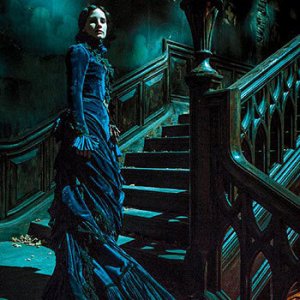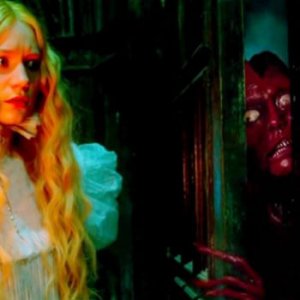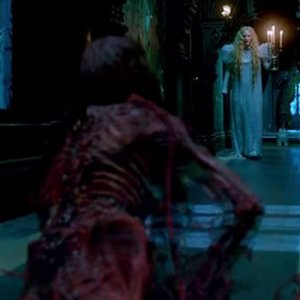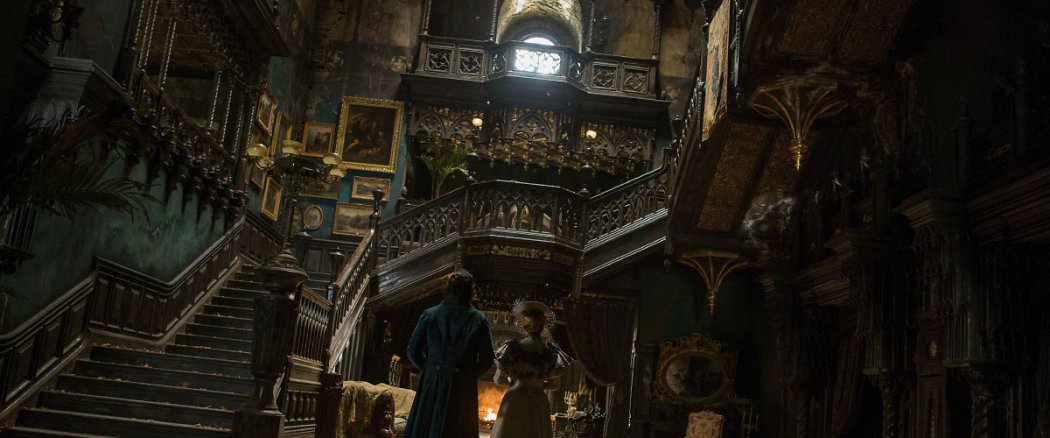There’s a point in every scary movie where things fall apart and they cease to be scary. Depending on what you’re actually afraid of, that could come very quickly. In Crimson Peak, the new ghost story from Mexican fantasist Guillermo del Toro, more than half the film is spent sans ghosts. By the time they actually show up there’s been enough mood-building and mystery to sustain the creepy atmosphere to the last scene.
As ghost stories go, it’s very traditional: there’s a lonely lead (Edith Cushing played by Alice in Wonderland’s Mia Wasikowska), a bleak locale, an unspooling mystery and at the heart of it all, a haunted house. The titular Crimson Peak is an impossibly vertically-sprawling estate slowly sinking into the red clay it was built upon. Generations of Sharpes have sustained their fortunes on this bloody earth, but as the new century dawns (1900) the last siblings, Sir Thomas Sharpe and his sister Lucille (Tom Hiddleston and Jessica Chastain), are faced with economic ruin. Through a series of unfortunate events wealthy American Cushing finds herself married to the penniless Baronet: her wealth becomes the key to reclaiming the family fortune. Cushing immediately finds herself oppressed by the house and its inhabitants (current and former).
Setting the Stage
 It’s not a brilliant ghost story, but the costumes and set design are reason enough to see Crimson Peak on the big screen. The ghosts themselves are shruggably obvious CG. A blend of practical and digital would have served the horror aspect better (see del Toro’s The Devil’s Backbone and The Orphanage to see what he can do without all the computer effects). But the house! Del Toro’s team scratch-built a 3-story Victorian Gothic mansion “fully functional, connected, and in various states of disarray” with a working elevator. Every detail from the wallpaper to the doorknobs to the grand staircase were practical sets lending to the feeling of a house that has gone mad with rot and misuse. The costumes were carefully planned to enhance the characters: the Sharpe’s clothes made them stand out as odd in the first half of the film but fit perfectly with the house — and vice versa with Cushing’s elaborate costumes. Colors play a huge part with red being the dominant symbol for the dying Sharpe dynasty. Everything in Crimson Peak — its people and its setting — is in a state of beautiful decay.
It’s not a brilliant ghost story, but the costumes and set design are reason enough to see Crimson Peak on the big screen. The ghosts themselves are shruggably obvious CG. A blend of practical and digital would have served the horror aspect better (see del Toro’s The Devil’s Backbone and The Orphanage to see what he can do without all the computer effects). But the house! Del Toro’s team scratch-built a 3-story Victorian Gothic mansion “fully functional, connected, and in various states of disarray” with a working elevator. Every detail from the wallpaper to the doorknobs to the grand staircase were practical sets lending to the feeling of a house that has gone mad with rot and misuse. The costumes were carefully planned to enhance the characters: the Sharpe’s clothes made them stand out as odd in the first half of the film but fit perfectly with the house — and vice versa with Cushing’s elaborate costumes. Colors play a huge part with red being the dominant symbol for the dying Sharpe dynasty. Everything in Crimson Peak — its people and its setting — is in a state of beautiful decay.
The Tragedy of Karma
Our best guess at moral truth as humans seems to be the idea of karma. Modern ghost stories from Ghost to The Sixth Sense to The Others to Crimson Peak have at their heart a karmic view of existence: We get our just desserts, sometimes in this life, sometimes in the next… and sometimes we get stuck in between until we can pay off the difference. Thus the Helpful Ghost and Walk Towards the Light tropes.
In Helpful Ghost we’re introduced to a terrifying specter (and del Toro’s ghosts are truly distorted, bloody, and minimally human) that turns out to be merely misunderstood! They exist to propel our heroine to the heart of the mystery. So we get whispered advice, pointing hands and elusive chases that lead to more clues and revelations. The Helpful Ghost doesn’t know its dead, or maybe it does and has to pay its dues before moving on. Seen through the lens of karma, ghosts are tragic figures, having most often died violently and undeservedly. A Helpful Ghost may even have been a terrible person in life but now they have the perspective of death which allows them to see the wrongness of their past. They want what we all want: peace and justice. (Except for Japanese ghosts! Don’t ever get involved with a Japanese ghost!)
tragic figures, having most often died violently and undeservedly. A Helpful Ghost may even have been a terrible person in life but now they have the perspective of death which allows them to see the wrongness of their past. They want what we all want: peace and justice. (Except for Japanese ghosts! Don’t ever get involved with a Japanese ghost!)
A Walk Towards the Light is usually the final step towards some religiously non-specific afterlife. With the exception of The Others, which ends in a sort of postmodern confusion, a Helpful Ghost will earn her reward through the course of the film. On the other side of the karmic coin we’ll often see unhelpful ghosts dragged to hell or cursed to annihilation. In Crimson Peak the ghosts are somewhat helpful, but it’s unclear if they have much agency or to what extent they are memories/emotional energies trapped by the house or its living inhabitants.
All is Grace
In Christian theology, karma is pure myth. Nobody “gets what they deserve”, either in this life or the next. As Bono once put it “Grace travels outside karma.” Bad people are regularly redeemed, and the worse they are the greater the redemption. Good people are rebuked for thinking their goodness can be used as a lever to manipulate God. The first shall be last and the last first. Jesus’ own followers are astonished at how he has overturned the karmic system: “If even the very good aren’t good enough, who can be saved?” they ask. Jesus replies “With God all things are possible.” Grace is something God pours out on the world, regardless of what we’ve done.
 The reason ghost stories so often mine the well of karma is that it seems right: it’s mathematical! But the subjective nature of the weight of our deeds makes it impossible to gauge where we stand at any given moment. “I’m glad I’m not as bad as THAT guy!” becomes our rallying cry… forgetting there’s someone standing downwind pointing back at us saying the same thing. Dante’s idiotic Divine Comedy dragged karma into the church, though we miss the fact that it’s the people Dante really doesn’t like that are guilty of the worst offenses (and thus earn themselves the most heinous punishments). More subjective karmic “justice”! It’s only Jesus who zeroes out the scales by forgiving his enemies and offering us hope no matter what we’ve done.
The reason ghost stories so often mine the well of karma is that it seems right: it’s mathematical! But the subjective nature of the weight of our deeds makes it impossible to gauge where we stand at any given moment. “I’m glad I’m not as bad as THAT guy!” becomes our rallying cry… forgetting there’s someone standing downwind pointing back at us saying the same thing. Dante’s idiotic Divine Comedy dragged karma into the church, though we miss the fact that it’s the people Dante really doesn’t like that are guilty of the worst offenses (and thus earn themselves the most heinous punishments). More subjective karmic “justice”! It’s only Jesus who zeroes out the scales by forgiving his enemies and offering us hope no matter what we’ve done.
The helpful dead and the tortured living in the ambitious and visually stunning Crimson Peak make sense of their world through the lens of karma. When all is said and done we get the sense that the goodies have triumphed and the baddies have fallen and the ghosts have gained some respite from all their chain rattling. Del Toro’s ghost stories follow a very well-trod path, and it fits all our expectations for how we want life to work. They are dark fairy tales, complete with the kind of uncomplicated moral lessons fairy tales often incorporate. But the skill and beauty of his world-building means that we’ll follow that path to the haunted house as long as he wants to keep sharing his vision with us.





